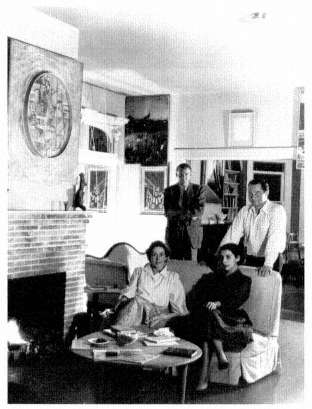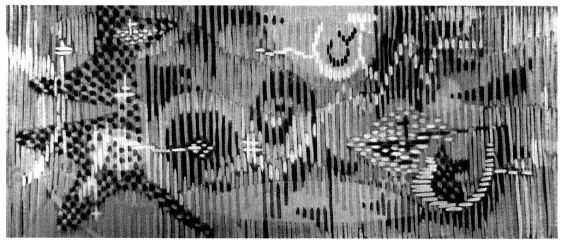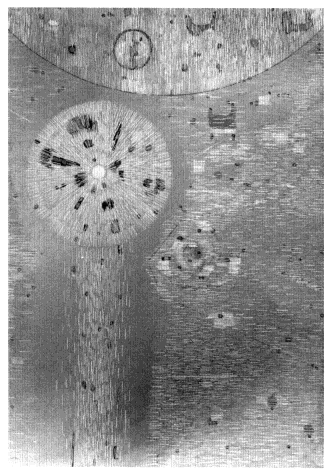Isle of Possibility: Gordon Onslow-Ford and the Dynaton
San Francisco, long a haven for nonconformists and eccentrics, was in the postwar period a mecca for artists, poets, and other members of a growing counterculture.[37] Here artists with modernist leanings developed a strong sense of community. San
Francisco was also a city poised, like all of California, "between the currents of the great old cultures of the Pacific and the stirring forces of America."[38] This openness to the cultures of Mexico and the Pacific Rim, and to the stream of international modernism, provided the catalyst for the Dynaton.
The Dynaton came into being in the late 1940s. Wolfgang Paalen had been brewing the postsurrealist experiment for five years in Mexico before moving to the Bay Area in 1948. As Lee Mullican recalled, "Paalen felt that there was an intellectual climate in San Francisco where something could really happen. The war had ended. We were all enthusiastic that ... this scene would be a growing center of culture. And the museum was sympathetic to what was happening."[39]
Some years earlier in France, prior to the outbreak of World War II, Gordon Onslow-Ford and the Chilean surrealist Roberto Matta had together developed the idea that the world of perception was only a section of a larger, invisible, order of existence in which everything was bound together into an indivisible whole.[40] When they joined André Breton's surrealist movement during its final phase in 1938, they had already developed their own approach to automatism, which had more to do with time and space than with Freud.[41] Together they reoriented the movement toward the more abstract and automatic foundation from which it had arisen in the early 1920s. This later form of abstract surrealism, which was so influential in the United States in the early 1940s, was more concerned with ideas about higher dimensions and with exploration of a fluid time-space continuum than the earlier version had been. Although surrealism is usually associated with the studies of Freud, it is clear that art at this time developed out of a matrix of influences and ideas, and that later surrealism owed as much to concepts about space and the fourth dimension as it did to psychology.[42]
When he arrived in the United States in 1941, Onslow-Ford became distinguished as surrealism's chief spokesman in the country until Breton came later that year. Onslow-Ford gave the first significant series of lectures on surrealism in the United States, at the New School for Social Research. Along with Howard Putzel, he also organized chronological exhibitions to accompany these lectures. Onslow-Ford was key to the assimilation of surrealist methodology and thought in the years when American art was coming of age.[43]
In 1941 Onslow-Ford went to Mexico, where the Austrian surrealist Wolfgang Paalen had moved two years earlier at the invitation of Diego Rivera and Frida Kahlo. Paalen's reputation had been established in 1936 in Paris, and he was one of the organizers of the Paris International Surrealist Exhibition in 1938, the year he met Gordon Onslow-Ford at the Café Deux Magots. Paalen's real contribution to international art came in Mexico, however, where he was inspired by the primal spirit of native American arts, the new physics, and the thought of John Dewey. In 1940 he helped Breton organize an international surrealist exhibition there.[44]
In Mexico Paalen published Dyn , one of the most avant-garde art journals flourishing internationally during the war. This interdisciplinary (mainly English-language)

Figure 74
Clockwise from top left : Lee Mullican, Cordon Onslow-Ford,
Luchita Hurtado, and Jacqueline Johnson in the San
Francisco home of Onslow-Ford and Johnson, ca. 1951.
Harry Bowden papers, Archives of American Art,
Smithsonian Institution.
review of art, archaeology, and science circulated theoretical and critical essays as well as illustrations of contemporary masters like Picasso and Henry Moore, and the emerging Robert Motherwell and Jackson Pollock. It especially focused on the native arts of the Americas and on art theory, advancing "an open-ended approach to art based on creativity's boundless potential."[45] Paalen saw automatism as a source of raw material for the artist but not as an end in itself. He published his "Farewell to Surrealism" in the first issue; Onslow-Ford, after officially resigning from the movement in 1943, contributed to the final issue. Dyn had a significant impact on expatriated European artists in the United States as well as the emergent New York School. During the war years it led many artists into surrealist phases, including Lee Mullican in 1943. Others with whom Paalen and Onslow-Ford were in close contact in Mexico were Motherwell and Matta. Motherwell recalled that "what we did ... as then-isolated Western intellectuals in Mexico, was to encourage each other in our various aspirations and with our various bits of knowledge."[46]
Onslow-Ford moved to the San Francisco Bay Area permanently in 1947, taking with him a formidable collection of twentieth-century modernist and pre-Columbian art (Fig. 74). He had a major retrospective at the San Francisco Museum of Art in 1948,
accompanied by the publication of his book Towards a New Subject in Painting . Lee Mullican returned from military duty, and Paalen also moved to the Bay Area in the late 1940s, where each had a retrospective at the San Francisco Museum of Art.
Paalen, Onslow-Ford, and Mullican soon discovered they shared common aims, and in 1949 they lived together for a few months in Paalen's Mill Valley house. In 1950 the artists exhibited together at Stanford University, with lectures by Sybil Moholy-Nagy, Onslow-Ford, and Paalen. Soon thereafter the artists were shown again, this time at the San Francisco Museum of Art in an exhibition they called the Dynaton .[47] In one of his two essays for the exhibition catalogue, Paalen wrote:
Our images are not meant to shock nor to relax; they are neither objects for mere aesthetic satisfaction nor for visual experimentation. Our pictures are objects for that active meditation which does not mean detachment from human purpose, but a state of self-transcending awareness, which is not an escape from reality, because it is an intuitive participation in the formative potentialities of reality.[48]
According to the group, the Dynaton (from a Greek word meaning "the possible") was a transformative art, a fusion of the artists' interests in pre-Columbian and native American cultures, shamanism, non-Western philosophies such as Zen Buddhism, the new physics (particularly wave-particle theory), and extraterrestrial life, all in an essentially meditative framework. The artists of the Dynaton espoused the principles of European surrealism—automatism and the primacy of the unconscious—and the vital quiet in California nature as their points of departure.
Nature was essential to the Dynaton. Paalen poetically referred to the work of each artist in terms of the four elements. "For Gordon the element is water and all it hides and bares, the moon, the neckline of the figurehead and the breath in the shell.... Air is the element for Lee, and all it carries, pollen, feathers, the dreams of birds and spikes of stars and the holy nest of winds ... the ray of sun on the straw." Paalen referred to himself as "the fire, the places where the devil cooks his ware."[49]
Onslow-Ford's Dynaton paintings radiate a sense of the artist's preternatural intimacy with nature. In A Stone That Dreamed (1950; Fig. 75) a vertical surface grid of broken color creates a screen through which pulsating dots subtly move. It is as though reality were coming into focus from behind a veil of illusion. Viewers, actively meditating, situate themselves in the kinetic space of the painting.[50]
According to Mullican, the Dynaton now floats in his memory "as a softened sun."[51] His mandala-like paintings (Fig. 76), reflective of the West's wide-open spaces and possibility for intimacy with nature, invited contemplation. Capturing the essence of vast expanses of sea, land, and sky, Mullican contributed "the sunlit fields and refractions of the West" to the aesthetic of the Dynaton.[52]
Soon after the 1951 San Francisco exhibition, the group disbanded. Paalen returned

Figure 75
Above Gordon Onslow-Ford. A Stone That Dreamed , 1950. Casein on paper
mounted on board, 36 × 85 in. Collection of the artist, Inverness, California

Figure 76
Left: Lee Mullican, Peyote Candle , 1951. Oil on canvas,
50 × 35 in Collection of the artist, Santa Monica, California.
to Mexico and Mullican moved to the Los Angeles area, where he has lived ever since, spending much time in New Mexico as well. Onslow-Ford moved to Mill Valley and later Inverness, where he now resides.
In retrospect, Onslow-Ford feels his contribution to art was only just beginning at the time of the Dynaton exhibition. Six months later he discovered a more direct expression of the deep structures of the mind in what he called line/circle/dot. It was then he felt he had discovered the root of all things and "the depths from which things grow."[53]
Both Onslow-Ford and Mullican (who also feels his own Dynaton paintings belong to a formative stage of his art) still find inspiration in their early breakthroughs with Paalen in San Francisco. The Dynaton artists, in addition to exhibiting an interest in native American culture and meditative states of consciousness, integrated Eastern philosophies into their art, thus exemplifying an early openness to Asian culture. This openness has been a continuing influence on American art and culture since the 1960s, but for an even longer time it has been intrinsic to the art of California, because of the state's location on the Pacific Rim.[54]